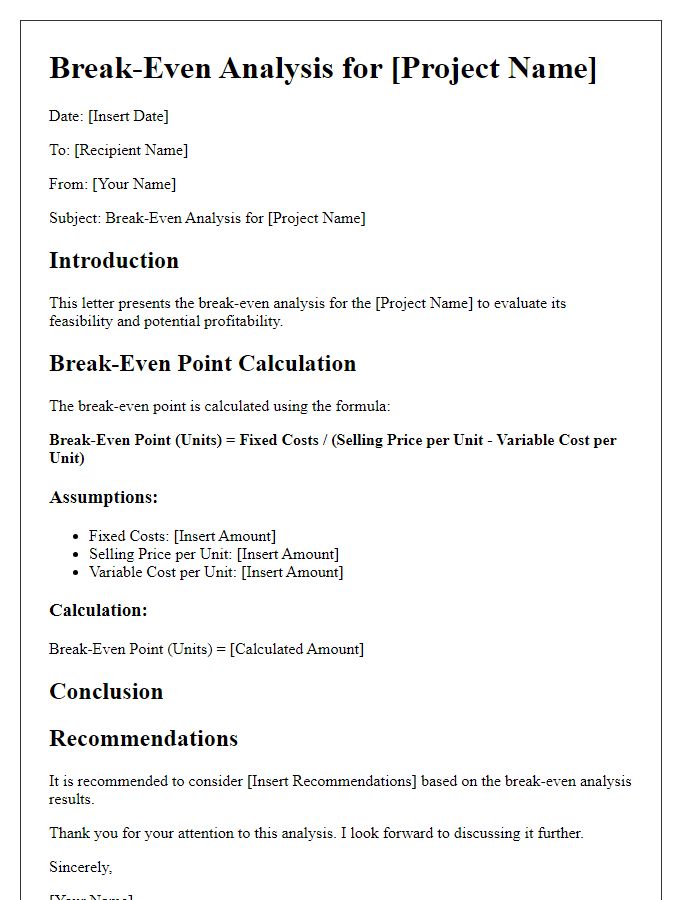Are you curious about the financial health of your business and how to achieve that crucial break-even point? Understanding break-even analysis can provide you with valuable insights into your costs, revenues, and profit margins, setting the stage for informed decision-making and strategic planning. In this article, we'll explore how to conduct a break-even analysis and the key factors to consider for optimizing your financial performance. So, let's dive in and uncover the secrets to mastering your business's break-even strategy!

Introduction and Objective
The break-even analysis report serves as a crucial financial tool for businesses aiming to determine the point at which total revenues equal total costs, resulting in no net loss or profit. This determination is essential for assessing the viability of new projects, product lines, or overall business strategies. The primary objective is to identify the break-even point in units sold or revenue generated, considering fixed costs (expenses that do not change irrespective of sales volume) and variable costs (expenses that fluctuate with production levels). Utilizing this analysis, stakeholders can make informed decisions regarding pricing strategies, cost management, and investment opportunities, ultimately enhancing profitability and financial stability.
Assumptions and Variables
A break-even analysis report evaluates financial data to determine the sales volume at which total revenues equal total costs, allowing businesses to assess profitability. Assumptions, such as a constant sales price of $50 per unit, fixed costs totaling $10,000 monthly, and variable costs of $30 per unit, are crucial for accuracy. Variables include sales volume, the point where total revenue meets total costs, and the time frame for analysis, typically spanning a fiscal quarter. Additional factors might encompass seasonal sales trends, market competition metrics, and external economic conditions, which can influence consumer purchasing behavior significantly. Understanding these elements aids in strategic planning and risk assessment for financial sustainability.
Fixed and Variable Costs
In a break-even analysis report, understanding fixed and variable costs is crucial for evaluating the financial health of a business. Fixed costs, such as rent (e.g., $3,000 monthly for office space in New York City), salaries of permanent employees (e.g., $50,000 annually for three staff members), and insurance premiums, remain constant regardless of production levels. In contrast, variable costs fluctuate with production volume; for example, raw materials might cost $5 per unit, while shipping expenses could average $2 per unit shipped. Calculating the break-even point requires determining the total fixed costs and dividing that by the contribution margin per unit; the contribution margin is derived from the selling price (e.g., $15 per unit) minus variable costs. Identifying these costs enables businesses to strategize pricing, optimize production, and ensure profitability in competitive markets.
Break-Even Point Calculations
A break-even analysis serves as a crucial financial assessment tool for businesses, determining the sales volume at which total revenues equal total costs (no profit, no loss). This analysis involves two primary components: fixed costs (such as rent, salaries, and insurance, totaling thousands of dollars per month) and variable costs (which fluctuate with production levels, including materials and labor costs). By evaluating sales price per unit, identifying the contribution margin (the sales price minus variable cost per unit), and applying the break-even formula--Fixed Costs divided by the Contribution Margin--businesses can calculate the break-even point in units sold. This critical figure aids in strategic decision-making, ensuring that organizations effectively manage their expenses while pursuing growth objectives, ultimately helping to sustain long-term profitability.
Sensitivity Analysis and Conclusion
Sensitivity analysis plays a crucial role in a break-even analysis report by determining how changes in key variables impact financial outcomes. In this analysis, variables such as sales volume, variable costs, and fixed costs are systematically adjusted to observe their effects on the break-even point (the number of units that must be sold to cover total costs). For example, an increase in variable costs by 10% may elevate the break-even point by a specific number of units, showing the risk sensitivity of profit margins to cost fluctuations. Conclusively, understanding these dynamics helps businesses like retail chains or manufacturing firms in strategic planning and decision-making, enabling management to formulate effective pricing strategies and cost control measures to enhance profitability and reduce potential financial risks. Insights gained from sensitivity analysis equip stakeholders with critical data to navigate market uncertainties confidently.













Comments